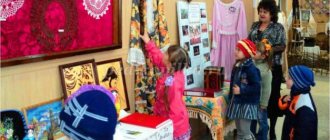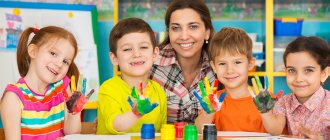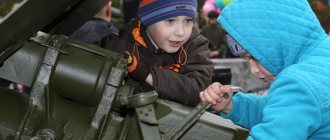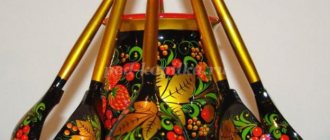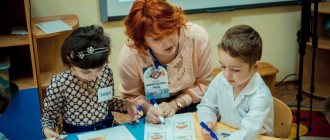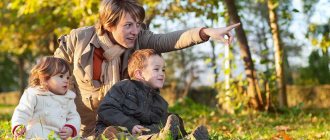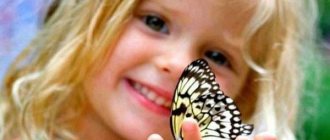This presentation will be of interest to teachers working in preschool institutions; environmental education is one of the important components in the education process.
The work is addressed to teachers of preschool institutions, and students of pedagogical faculties can also use it.
The presentation reflects a developing subject-spatial environment, organized to form the principles of ecological culture in children of primary preschool age.
Speech for presentation
SLIDE 1 Hello, dear colleagues.
The topic of my speech is “Modern approaches to the formation of the principles of environmental culture in children of primary preschool age.” She started working with children aged 2-4 years in 2013.
As we all know, people living in modern society have many problems. But perhaps one of the most acute and pressing is the problem of environmental conservation. We are already accustomed to conversations that the world is on the brink of an environmental catastrophe, that more and more new species of plants and animals are disappearing from the earth, and that we are physically suffering from air, water, and soil pollution.
SLIDE 2 In order to attract public attention to the issues of environmental development of the Russian Federation, conservation of biological diversity and ensuring environmental safety, 2022 has been declared the year of ECOLOGY in Russia.
I believe that the foundations of environmental education should be laid in early preschool age.
In the process of environmental education, children develop cognitive interest in the natural world, curiosity, and creative activity.
One of the important components of environmental education is a developing subject-spatial environment. To begin with, I would like to say a few words about the conditions that have been created in our preschool educational institution.
SLIDE 3
For five years, our kindergarten has been working in a priority area - the cognitive development of preschoolers, in particular environmental education. To develop an emotional and value-based attitude towards the nature around us, our kindergarten teachers have created an ecological room. Slide 4 At the entrance we are always greeted by the owner of the room “Mushroom - Borovik”.
SLIDE 5
The following zones are allocated in the ecological room :
1. Collections and display materials area . Slide 6-7 This zone is intended to introduce children to various natural objects, to develop their sensory skills, skills of classifying objects according to various criteria. The collection material also serves as visual material.
2. Library area. SLIDE 8
this is a corner in which colorful books, encyclopedias for children, children's atlases, homemade books on the topic: “Nature through the eyes of children” based on the works of Vitaly Bianki, Evgeny Charushin, and other writers are collected.
SLIDE 9 Next to the library area there is an exhibition of reproductions of paintings by great landscape artists, and next to them are works of our students, possibly future great artists.
3. Russia includes almost all climatic zones that exist on earth. SLIDE 10 Designed natural climatic zones : Arctic, forest-steppe, tundra, desert, tropics allow preschoolers to be introduced to the plants and animals of our country.
4. Laboratory area SLIDE 11
Here conditions have been created for the development of cognitive and research activities in children, the formation of the foundations of a scientific worldview. Working in the laboratory involves turning children into scientists who conduct experiments, experiments, and observations on various topics.
5. Relaxation area . SLIDE 12
Helps relieve tension or fatigue in children, which arises as a result of receiving a huge amount of information. A stream and indoor plants are presented here. The murmuring of the stream and quiet music encourage children to relax and play independently.
an experimental plot has been created on the territory of our preschool institution , where pupils carry out experimental research activities, observe the growth of various plants and how to care for them, grow onions and herbs in the garden for our table, and instill the first labor skills.
There is also an ecological trail here,
SLIDE 14 with a length of about 500 meters, which performs cognitive, developmental, aesthetic and health-improving functions. Helps to develop in children a conscious attitude towards their native nature, since children take an active part in the creation and preservation of natural resources.
SLIDE 15 There is non-standard equipment on the ecological trail.
SLIDE 16 I use the created developmental subject-spatial environment in the formation of the beginnings of the ecological culture of younger preschoolers.
Younger preschool age is the most valuable stage in the development of the beginnings of children's ecological culture.
SLIDE 17 Objects of nature attract children, first of all, with their beauty, bright colors, variety, and this is the source of the first concrete knowledge and joyful experiences, often remembered for a lifetime.
Familiarization with the natural world is one of the sections of cognitive development, and therefore there is a need for its integration into other educational areas.
Social and communicative development. The introduction of a new educational standard orients teachers towards the playful nature of the educational process, since play is the most accessible and interesting activity for a preschooler. In order to form in children a sense of belonging to all living things, to instill in children responsibility towards every living being, be it a plant or an animal, I began to use environmental and psychological trainings.
SLIDE 18 For a few minutes, the children and I “turn” into bugs, butterflies, ladybugs, kittens and bunnies.
SLIDE 18 After experiencing emotions, the child can relax in the “Retreat Center”.
One of the favorite forms for children was interviewing. Listen to how the children of the 2nd junior group answered the question “What is nature?”
Cognitive development.
SLIDE 19 To work with children in a group, I organized an ecological space “Nature Center”, which includes a nature calendar; library; dummies of vegetables and fruits; games: didactic, board-printed, dramatization games, various illustrations and reproductions about nature, the seasons, domestic and wild animals were selected.
SLIDE 20. In the experimentation center, children can conduct experiments with water and sand at any time; study their properties, play with them, show creative qualities, develop imagination, as well as fine motor skills.
Slide 21 The “Vegetable Garden on the Window” project allows you to expand children’s understanding of plants, where they grow, the necessary conditions for their growth, and develop their interest in cognitive and research activities.
SLIDE 22 To gain primary knowledge, get acquainted with nature, and strengthen children’s skills, I developed a model of a “Village Yard” consisting of models of domestic animals
SLIDE 23 One of the effective methods when working with children to form the principles of environmental culture is the project method. In my work, I implemented the projects “Indoor Plants” and “Magic Drop”. The goal of the “Indoor Plants” project was to form ideas about living conditions in rooms. plants, rules for caring for them. The goal of the “Magic Drops” project is to form ideas about the properties of water, the role of water in human life and other living organisms; fostering a caring attitude towards the natural resources of our planet.
As part of the “Indoor Plants” project, I organized the “Give a Plant to a Kindergarten” campaign and the “Bereginya” resource-saving campaign, the goal of which was to form an environmental culture and worldview in children and adults and to cultivate a careful attitude towards water.
Speech development.
SLIDE 24 Nature is a rich source of aesthetic experiences and vocabulary development for preschoolers. The simplest thing I started with was reading good fairy tales about animals, looking at pictures of animals, birds and plants. In addition to fairy tales, I use other works of folklore, poems, the plots of which are played out with children. In the mummers corner, children are happy to change their appearance, dressing up in animal costumes, their favorite fairy-tale characters, where they feel relaxed and free. The speech of younger preschoolers also develops well during walks.
SLIDE 25 While walking, kids ask a lot of questions, many of which stimulate the thinking process and require the expression of emotions and thoughts using words.
Physical development
SLIDE 26 Physical education and health work also contributes to the environmental education of children through physical education classes, physical education holidays, leisure activities and excursions, which, on the one hand, promote the development of motor skills and abilities of pupils, strengthen their health, and on the other hand, cultivate a deep understanding of the multifaceted significance of nature for people's lives.
Artistic and aesthetic development
SLIDE 27 Fine art, artistic expression, and music allow us to convey perceived beauty, capture those objects and phenomena that we liked, and share our experiences with loved ones; Their creative activity awakens and develops, creativity is formed.
We all know that children love holidays and entertainment.
SLIDE 28 Their role is to have a strong impact on the emotional sphere of the child’s personality. It is important in such holidays that children are involved in experiencing events, in awareness of environmental problems that are understandable to children.
And yet, instilling in children a positive attitude towards nature is only possible when parents also have an ecological culture. Children behave like the adults around them. Parents need to realize this.
SLIDE 29 Various forms of interaction with parents: surveys, consultations, parent meetings, presentations, trainings, exhibitions, projects, seminars, competitions, leisure activities allow us to combine efforts to develop and educate children in the principles of environmental culture;
SLIDE 30 Thus, I believe that environmental education has a positive effect on the development of a child’s personality: it develops a sense of responsibility for the nature of the native land, fosters a humane attitude towards the environment, and forms initial environmental ideas in children of primary preschool age.
Author: Martynova Ekaterina Sergeevna, teacher at MBDOU DS "Rucheyok" r.p. Bashmakovo, Penza region, Bashmakovsky district, Russia.
The article is published in the author's edition
Organized forms of teaching environmental education for children. - presentation
Organized forms of teaching environmental education for children.
1. Organized: – excursions (to a forest, park, meadow, pond, etc.), – NOD (educational, combined, complex), – observations of animals and plants, natural phenomena, human activities in nature.
2. Joint activities: - observations in a corner of nature, work in a corner of nature, - targeted walks in nature, hikes, - reading works of art about nature (poems, stories, fairy tales), looking at illustrations in books, environmental fairy tales, - looking at paintings from the lives of wild animals, artists I.I. Levitan, A.K. Savrasov, V.D. Polenov, I.I. Shishkin, K.F. Yuon and others - stories from the teacher about animals, plants, inanimate nature. about nature reserves, reserves, natural monuments, etc., - work with models, - conversations and discussions with children on environmental topics, - collecting collections, seeds, stones, leaves, - environmental holidays and leisure activities (Bird Day, Earth Day, birth of the Forest, etc.), - experiments, search activities in an environmental circle or laboratory of a young researcher, - marathons, auctions, promotions, - environmental trainings with discussion and playback of situations, - ecological trails, - games (outdoor, didactic, theatrical, musical, intellectual KVN, Field of Miracles and What, Where, When?, – various types of visual activities on environmental themes, – working with nature calendars, observation diaries, – making and playing out models (zoo, wild animals, pets, animals of hot countries) and panel (the forest is our wealth, where there is water in nature, who lives in the sea).
Methods of environmental education
The verbal method is associated primarily with reading natural history literature: the reading of stories, questions to the text, explanations of the teacher, children's retelling, conversation about what they read - all these are different forms of speech activity that allow the child to understand new information and realize natural phenomena that are often inaccessible to observation. , their relationships with each other.
It is advisable to record systematic observations of the same natural phenomena in calendars. In this case, various changes in plants, animals, inanimate natural phenomena, as well as the conditions under which these changes occurred, can be traced. Displaying events with pictures, icons, or schematically is important primarily for the effectiveness of the observation itself - the child returns to the ideas and impressions that he received while looking at an object of nature, and thereby consolidates them, clarifying the details and features. Observations of seasonal natural phenomena in all age groups are planned for one week of each month (hence the name of the technique - “weekly”). Observations of the weather, examination of trees and shrubs, ground cover, search and identification of animals (birds, insects, amphibians, reptiles) are accompanied by keeping a calendar in which the day of the week and weather are recorded daily, at the end of the week a picture of wildlife is depicted, reflecting the state of plants and animals of the site in a given week of a given month. Depending on the age of the children, observations are recorded either with a ready-made picture or with icons - pictograms. Recording of observations in the calendar is carried out under the direct supervision of the teacher, who first shows, teaches, and then helps and controls the children’s independent actions. A completed nature calendar (at least three months) reflects seasonal changes in nature, its ecological regularity - the dependence of the state of plants and animals on factors of inanimate nature. Working with a calendar develops visual, figurative and schematic thinking of preschoolers.
Of particular importance for the environmental education of preschoolers are calendars - screens in which the same objects are recorded at regular intervals. For example, a growing and developing plant is regularly sketched on a calendar once a week. In this case, the generalizing role of the calendar is that its several pages make it possible to compare an object that changes as a result of its growth and development. Drawings, better than observation itself, help to identify what has changed (grew, new leaves, buds, etc.) and what has remained unchanged. Of particular importance is such a calendar - a screen, in which not only changes in the object of observation (plants) are recorded, but also the conditions under which these changes occurred, i.e. the actual ecological connections: the dependence of the state, growth and development of the plant on environmental factors. In this case, the connections in nature become clear: the calendar helps the teacher demonstrate them to the children. This is important for preschoolers because they learn cause and effect relationships at the level of visual and figurative thinking.
An irreplaceable method of environmental education is the work of children in a corner of nature. The ecological approach to the organization of labor in nature is that it should be considered as a process of creating conditions for living beings - the inhabitants of a children's institution. The focus should be on the plants and animals being cared for: their condition and well-being, the conditions in which they are currently located. The work of caring for plants and animals is the replenishment of those components of the environment that are currently missing, or are insufficient, or are not of the quality required by the plant or animal in accordance with their needs. Work in nature is, first of all, a humane attitude towards all living things that surround a child, it is an understanding of the prosperous or unfavorable state of the inhabitants of a corner of nature, it is sympathy and pity, it is a desire for them to feel good. And only secondarily, labor in nature is the correct actions and operations with care items and equipment. In the organization of any work in nature - whether it is joint work between a teacher and a child, or planned duty in a corner of nature, or collective work on a site - it is necessary to clearly distinguish three stages: - inspection - observation of living objects, identifying their condition and well-being; — labor activity in the set and volume that were determined during the inspection; - a final observation that allows us to assess the usefulness of the habitat for living organisms.
Experimenting with natural objects. Experiments reveal the relationship between plants and animals and the external environment; purposeful, logically structured conversation leads children to an understanding of causal relationships in nature. Such experimentation creates a solid empirical basis for understanding natural dependence. The formation of the same idea, i.e. Understanding the nature of the relationship between living beings and the environment occurs at the final stage of experimentation - in a special lesson of an in-depth cognitive type. In this lesson, the results of the experiments are discussed. The logic of the conversation finds its expression in a certain sequence of discussion, namely: the state of the objects of observation at the beginning of the experiment (the same); the state of the objects at the end of the experiment (various); comparison of experimental conditions - identification of identical and different environmental factors; conclusion about the dependence of the different states of objects at the end of the experiment on the influence of different external conditions.
Using didactic games. Play is the leading activity of children during preschool childhood; it enriches and develops personality, therefore it should be as widely used in environmental education as in other areas of education. Didactic games are used with gradual complication of the task. Games contribute to the all-round development of children, and are especially important in mental education and sensory development. Games combine a didactic element with entertainment, emotionality, a game concept with the ease of completing a task. The content of the game action is provided in the didactic toy itself, and the final result is determined in it. Play brings joy to a child, so learning about nature and communicating with it, taking place against its background, will be especially effective; the game creates optimal conditions for education and learning.
Classification of environmental games: role-playing; imitation; competitive; didactic; travel games.
MAGAZINE Preschooler.RF
“A man became a man when he heard the whisper of leaves and the song of a grasshopper, the murmur of a spring stream and the ringing of silver bells in the bottomless summer sky, the rustle of snowflakes and the howling of a blizzard outside the window, the gentle splash of a wave and the solemn silence of the night - he heard, and, holding his breath, listens hundreds and thousands of years of wonderful music of life.” V. A. Sukhomlinsky. Relevance of the work Early age is the most favorable time for sensory development, for the accumulation of ideas about the world around us. Environmental education can and should begin from the moment a child enters kindergarten. Goal: To develop a consciously correct attitude of children towards nature, to form in them the foundations of environmental consciousness. Tasks:lay the first ideas and guidelines in the natural world; promote the development of children's cognitive and speech skills; to cultivate in children a humane and aesthetic attitude towards nature.
Methods of working with parents: conversations; requests for help in designing and enriching the subject-developmental environment of the group; tasks; moving folders.
Methods of working with children: observations of living and inanimate objects; experimental activities; outdoor and didactic games; direct educational activities; use of illustrative and visual material; reading children's natural history and fiction literature; feasible labor in nature.
Subject-based development environment Children's visual activities Goal: familiarization with paints, learning to draw using the poking method, showing that you can draw with your fingers and potatoes. Finger painting on a tray of salt “Fun Fingers” Purpose: to show children that they can draw with salt. Development of fine motor skills. GCD “Sand House for a Turtle” Purpose: familiarization with the properties of sand: dry - pours, wet - molds. Game “What Floats How” Goal: familiarization with the properties of stones. Let's compare a stone with a wooden stick: which is lighter, which is heavier, which sinks in water, which floats. Game “Get a Pebble” Goal: familiarization with the properties of stones by shape, weight, development of attention. Game “Warm - Cold” Purpose: familiarization with the properties of water: transparent, warm, cold. Observing water in an artificial waterfallGoal: familiarization with the properties of water: flowing, murmuring, splashes flying, droplets dripping. GCD “House for Fish” Purpose: familiarization with the structure of the aquarium: the bottom is covered with sand, the sand is wet; the stones are buried in the sand, they are also wet, dark, large and small; the water is clear and clean. ECD “Pets” Goal: getting to know pets, developing speech activity. ECD "Kitty-Murysonka" Goal: getting to know the cat (body parts: head, body, tail, paws), developing speech activity. Bird watchingGoal: to introduce children to birds: dove and sparrow. Examination of body parts. Doable work in nature “Car path” Goal: to accustom children to work in nature. Experimental activity “Ice” Goal: to continue to introduce the properties of water: warm, cold. Show the children that a piece of ice will melt faster in warm water.
I would like to believe that the love of nature will remain in the hearts of our students for many years and will help them live in harmony with the world around them.
| Next > |
